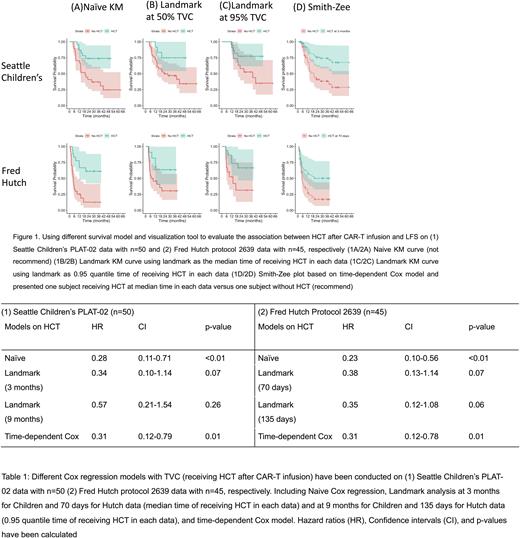Abstract
Introduction
Consolidative hematopoietic cell transplantation (cHCT) after CAR-T is frequently performed for patients with acute lymphoblastic leukemia (ALL) but the role of HCT is debated. To estimate the association between receipt of HCT and survival, HCT should be considered as a time-varying covariate (TVC), because HCT can occur later after CAR-T infusion. Cox models and Kaplan Meier (KM) curves that treat the TVC (HCT vs no) as known at study entry (Naïve methods) are not appropriate. Ignoring the time from day 0 to the day of TVC status change may lead to immortal person-time bias. Landmark analysis is a popular alternative that chooses a time (3 months after CAR-T) as a new start time and use the TVC status by landmark for Cox model/KM curve. However, patients who had events or were censored before landmark will be excluded and change in TVC after landmark is ignored. Also, results could be sensitive to the choice of landmark times (3 or 9 months). Time-dependent (TD) Cox are recommended to analyze TVC but constructing survival curves with TVC is not straightforward. Recently, a new visualization method was proposed by Smith et al., 2019 (Smith-Zee). Based on a TD Cox model, Smith-Zee constructs survival curves by mimicking new patients with TVC status change at different times, which overcomes drawbacks of the Naïve and Landmark methods. There is un urgent need to guide both clinicians and statisticians on how to analyze TVC using appropriate models and curves.
Methods
We developed a R Shiny tool, called TimeDep_survival_curvesTM, with different models (Naïve, Landmark, TD Cox) and curves (Naïve KM, Landmark KM, Smith-Zee) for TVC analysis https://samplen.shinyapps.io/TimeDep_survival_curves/. The tool includes several unique features: 1) protects data privacy yet allows users to upload data directly 2) applies different methods on the same data and shows potential biases of inappropriate methods 3) contains a simulation panel that allow users to specify the parameters based on various study settings.
Results
Individual trials showed conflicting results as to whether HCT benefit patients with B-ALL after CAR-T. The finding divergence might be related to the different statistical methods used (TD Cox vs Naïve). Here,we re-analyzed two CAR-T trials (Fred Hutch: NCT01865617, Seattle Children's (SC): NCT02028455) using Naïve, Landmark, and TD Cox models to evaluate the impact of HCT after CAR-T with leukemia-free survival (LFS). For SC trial, the estimated hazard ratio (HR) and p-value for HCT from the Naïve method are similar to those from the TD Cox (Table 1: Naïve HR=0.28/p<0.01 and TD Cox HR=0.31/p=0.01). For landmark analysis, as we expected, different landmark times (3 vs 9 months) showed different results (Table 1: HR=0.34/p=0.07 for 3 vs HR=0.57/p=0.26 for 9 months) as well as the curves (Figure 1). For Hutch trial, we obtained the same conclusions: HRs and p-values are similar across different models (Table 1). The consistent results from both trials provide reassurance that the impact of HCT may not be specific to the methods used for analysis. However, to understand when the bias from the Naïve method might lead differences in conclusion, we performed simulation (Simulation on R Shiny) and observed the bias from Naïve methods is greater if more patients received HCT later after CAR-T, or if more patients have an event (LFS or OS) sooner (i.e., the shape parameter k of Weibull distribution for time to TVC, ktvc > 1 or for time to event, kevent < 1). When more patients' events occur later (kevent > 1) and undergo HCT sooner (ktvc < 1), the bias from Naïve method is minimal, like what we observed in two CAR-T studies.
Conclusion
For these two studies, the effect of HCT seems to be consistent across methods, however, this is not generally true. Based on simulation, significant bias might be generated when using Naïve methods for TVC analysis. We recommend to use TD Cox model and Smith-Zee curve. Our R Shiny tool can analyze different TVCs, e.g., HCT (vs no), MRD-CR (vs no), B-cell recovery (vs B-cell aplasia). More importantly, our tool breaks collaboration barriers since it does not require data sharing between institutions. Users can upload data and download results independently without technical coding skills. It critically expands upon the limited tool available, in turn leads to better understandings of the efficacy of immunotherapies, and no doubt will benefit the statistical and medical communities worldwide.
Disclosures
Gauthier:Multerra Bio: Consultancy; Celgene (A BMS Company): Research Funding; Kite Pharma: Consultancy; Legend Biotech: Consultancy; Sobi: Research Funding; Juno Therapeutics - A BMS Company: Research Funding. Vinaud Hirayama:Bristol Myers Squibb: Honoraria; Novartis: Honoraria; Juno Therapeutics, a BMS Company: Research Funding; Nektar Therapeutics: Research Funding. Turtle:Eureka Therapeutics: Current holder of stock options in a privately-held company, Membership on an entity's Board of Directors or advisory committees; Caribou Bioscience: Current holder of stock options in a privately-held company, Membership on an entity's Board of Directors or advisory committees; T-CURX: Membership on an entity's Board of Directors or advisory committees; Juno Therapeutics, a BMS Company: Patents & Royalties, Research Funding; Nektar Therapeutics: Membership on an entity's Board of Directors or advisory committees, Research Funding; Precision Bioscience: Current holder of stock options in a privately-held company, Membership on an entity's Board of Directors or advisory committees; Decheng Capital: Consultancy, Membership on an entity's Board of Directors or advisory committees; GlaxoSmithKline: Membership on an entity's Board of Directors or advisory committees; Kite Pharma, a Gilead Company: Membership on an entity's Board of Directors or advisory committees; Expert Connect: Consultancy; Myeloid Therapeutics: Current holder of stock options in a privately-held company, Membership on an entity's Board of Directors or advisory committees; Arsenal Bio: Current holder of stock options in a privately-held company, Membership on an entity's Board of Directors or advisory committees; Century Therapeutics: Membership on an entity's Board of Directors or advisory committees; Allogene: Membership on an entity's Board of Directors or advisory committees; Prescient Therapeutics: Membership on an entity's Board of Directors or advisory committees. Gardner:Juno Therapeutics: Patents & Royalties; Novartis: Honoraria; Crispr Therapeutics: Honoraria.
Author notes
Asterisk with author names denotes non-ASH members.


